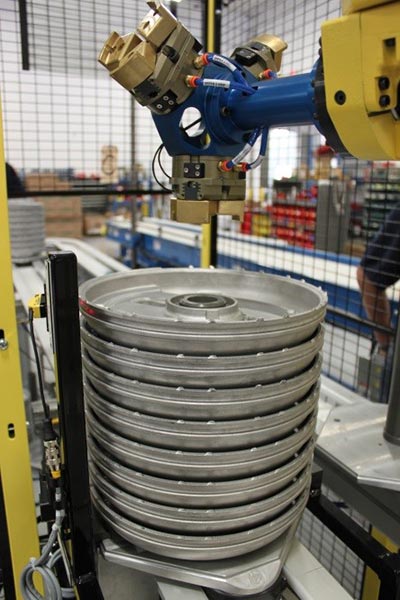
Robotic End of Arm Tools: Get a Grip on Your Product
Rob Stepanek | 03 February 2015
Robotic end of arm tools, although just a small piece of robotic systems, are extremely important. There are many different designs and methods for them to grip products, and they can be used in many different ways. Here are some of the ways this gripping action can be accomplished.
Gripper EoAT
This might be the first idea that comes to mind when thinking of an EoAT, a pneumatically actuated precision cylinder mounted to the faceplate of the robot. Customized fingers are mounted onto the moveable plates of the cylinder to clamp onto the product. The motion of these cylinders can be two plates running parallel to each other, three plates moving radially/concentrically to each other, or angularly (pivoting away from/toward each other). The distance the cylinder travels can range from just a few millimeters for the smallest grippers up to a couple of inches on larger ones.
Machine Tending EoAT
In a robotic machine tending application, an EoAT typically uses a gripper but with a twist. The precision required to interface with a CNC machine is much higher than in other applications. Locating pins and extra attention to tolerance stack-up are necessary to achieve this precision. Also, consideration must be given to the clamping motion needed. That is, whether to clamp on the part from the outside (closing the cylinder) or from the inside (opening the cylinder). Sometimes both are required.
Compression EoAT
As the name implies, this action involves squeezing two plates together. This can be accomplished using a ball screw driven with a motor or a linear guide rail powered by pneumatic cylinders. This type of gripping action can be used on larger products to palletize them very close to each other. Travel distances of several inches can be achieved with this style.
Vacuum EoAT
Sometimes it is very difficult or impossible to clamp the product. The product may not be rigid enough (as in large sheet metal) or need to be set next to other products without any gap (box palletizing). In this case, suction cups and vacuum can be used to grip product. Many variables go into selecting the right suction cup, including:
- What is the durometer and material of the cup’s contact surface? Will the cup mar the product?
- Is it better to use fewer large cups or many smaller cups? The force generated by each cup with a certain vacuum level plays a large part in that decision.
- How quickly does the necessary vacuum level need to be achieved? This drives the location of the vacuum generating equipment. When the cycle time needed is a second or two, one can’t wait a second to create the proper vacuum. The less air there is to evacuate, the faster vacuum can be drawn. However, that is not the only thing that achieves vacuum more quickly.
- The porosity of the product is also an important consideration. If air is drawn through the product into the volume where a vacuum is desired, the system has to work that much harder.
Using an array of suction cups, one can also incorporate zones of control. By selecting the zones that get turned on and off, single or multiple items can be picked up. This makes the EoAT very flexible in order to pick, say, four products at a time and place two at a time to accommodate various layer patterns as seen in the video below.
Combinations
Of course, not all applications are cut and dry. Sometimes it is necessary to use a combination of actions. We recently utilized vacuum and compression in one EoAT. In this application vacuum was used to pull a box into the EoAT while the top plate clamped down to contain the box as it was turned upside-down to empty the contents.
This summarizes some basics in gripping actions but is by no means the limit of options available. Our robotics experts at Bastian Solutions are happy to work with you to design the most effective way to get a grip on your product. Contact us today.
Comments
15 Popular Posts from 2015: Material Handling Tech Trends | The Material Handling Blog says:
8/28/2018 10:09 AM
[…] Read: Robotic End of Arm Tools: Get a Grip on Your Product (part II) […]
Leave a Reply
Your email address will not be published.
Comment
Thank you for your comment.